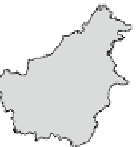Geoscience Reference
In-Depth Information
Fig. 5.7
El Tránsito, Nicaragua
after the tsunami of September 2,
1992. While the second wave,
which was 9 m high at this site,
destroyed most of the houses,
only 16 out of 1,000 people died
because most fled following the
arrival of the first wave, which
was much smaller. Photo Credit
Harry Yeh, University of
Washington. Source NOAA
National Geophysical Data
Center
Pacific Ocean. A 1 m wave was measured on tide gauges on
Easter
100°
110°
120°
130°
and
Galapagos Islands, and
a 10 cm wave
was
5°
measured at Hilo, Hawaii, and Kesen'numa, Japan.
Celebes Sea
0°
Borneo
5.4.2
Flores, December 12, 1992
5°
Java Sea
Ambon
Sulawesi
Banda Sea
The Flores Tsunami occurred at 1:29 PM (05:29 UTC) on
December 12, 1992 along the north coast of the island of
Flores in the Indonesian Archipelago (Fig.
5.8
). An earth-
quake as the result of back-arc thrusting of the Indo-Aus-
tralian Plate northward beneath the Eurasian Plate generated
the tsunami (Yeh et al.
1993
; Shi et al.
1995
). The earth-
quake had a surface wave magnitude, M
s
, of 7.5. Damaging
earthquakes and their tsunami have tended to increase in the
Flores-Alor region since 1977, with at least nine earth-
quakes being reported beforehand. The 1992 earthquake
had an epicenter at the coast and produced general subsi-
dence of 0.5-1.0 m. Within 2 or 3 min a tsunami arrived
ashore to the east, and within 5 min the tsunami reached
most of the coastline where damage occurred. The tsunami
wave train consisted of at least three waves, with the second
one often being the largest. The first wave, which came in as
a wall, was preceded by a general withdrawal of water.
Submarine landslides triggered by the earthquake may
explain many of the tsunami's features including the small
number of waves in the wave train and the larger run-up
heights and shorter arrival times eastwards (Fig.
5.8
). Run-
up heights varied from 2-5 m in the central part of the
island, to as much as 26.2 m in the village of Riang-Kroko
406 inhabitants were killed. This tsunami is only one of
three that occurred in the twentieth century with run-up
Indian Ocean
10
°
Timor Sea
Flores Sea
Riang-Kroko
Flores
Babi Island
0
50
100 km
Earthquake
epicentre
Height of
tsunami
(= 5 m)
Fig. 5.8
Location and height of Flores, Indonesian Tsunami of
December 12, 1992. Based on Tsuji et al. (
1995
). Height bars are
scaled relative to each other
exceeding more than 20 m. Overall, two thousand deaths
occurred as the waves destroyed entire villages (Tsuji et al.
1995
). Damage was especially heavy on Babi Island, which
lies 5 km offshore of the coast. Here the tsunami refracted
around to the landward side of the island and ran up to
heights of 7.2 m above sea level on the southwest corner
(Yeh et al.
1994
). Of the 1,093 inhabitants on this island,















































































































































































